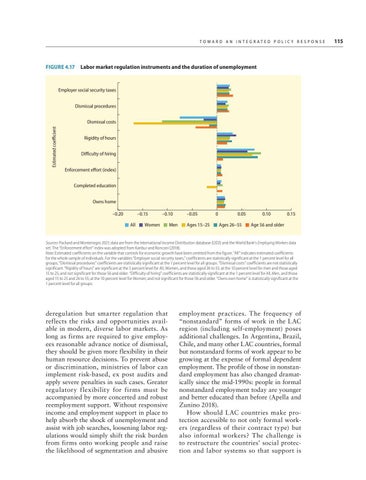T o w a r d a n I n t e g r a t e d P o l i c y R e s p o n s e
FIGURE 4.17 Labor market regulation instruments and the duration of unemployment
Employer social security taxes Dismissal procedures
Estimated coefficient
Dismissal costs Rigidity of hours Difficulty of hiring Enforcement effort (index) Completed education Owns home –0.20
–0.15 All
–0.10
Women
Men
–0.05 Ages 15–25
0
0.05 Ages 26–55
0.10
0.15
Age 56 and older
Sources: Packard and Montenegro 2021; data are from the International Income Distribution database (I2D2) and the World Bank’s Employing Workers data set. The “Enforcement effort” index was adopted from Kanbur and Ronconi (2018). Note: Estimated coefficients on the variable that controls for economic growth have been omitted from the figure. “All” indicates estimated coefficients for the whole sample of individuals. For the variables “Employer social security taxes,” coefficients are statistically significant at the 1 percent level for all groups; “Dismissal procedures” coefficients are statistically significant at the 1 percent level for all groups. “Dismissal costs” coefficients are not statistically significant. “Rigidity of hours” are significant at the 5 percent level for All, Women, and those aged 26 to 55; at the 10 percent level for men and those aged 15 to 25; and not significant for those 56 and older. “Difficulty of hiring” coefficients are statistically significant at the 1 percent level for All, Men, and those aged 15 to 25 and 26 to 55; at the 10 percent level for Women; and not significant for those 56 and older. “Owns own home” is statistically significant at the 1 percent level for all groups.
deregulation but smarter regulation that reflects the risks and opportunities available in modern, diverse labor markets. As long as firms are required to give employees reasonable advance notice of dismissal, they should be given more flexibility in their human resource decisions. To prevent abuse or discrimination, ministries of labor can implement risk-based, ex post audits and apply severe penalties in such cases. Greater regulatory flexibility for firms must be accompanied by more concerted and robust reemployment support. Without responsive income and employment support in place to help absorb the shock of unemployment and assist with job searches, loosening labor regulations would simply shift the risk burden from firms onto working people and raise the likelihood of segmentation and abusive
employment practices. The frequency of “nonstandard” forms of work in the LAC region (including self-employment) poses additional challenges. In Argentina, Brazil, Chile, and many other LAC countries, formal but nonstandard forms of work appear to be growing at the expense of formal dependent employment. The profile of those in nonstandard employment has also changed dramatically since the mid-1990s: people in formal nonstandard employment today are younger and better educated than before (Apella and Zunino 2018). How should LAC countries make protection accessible to not only formal workers (regardless of their contract type) but also informal workers? The challenge is to restructure the countries’ social protection and labor systems so that support is
115

